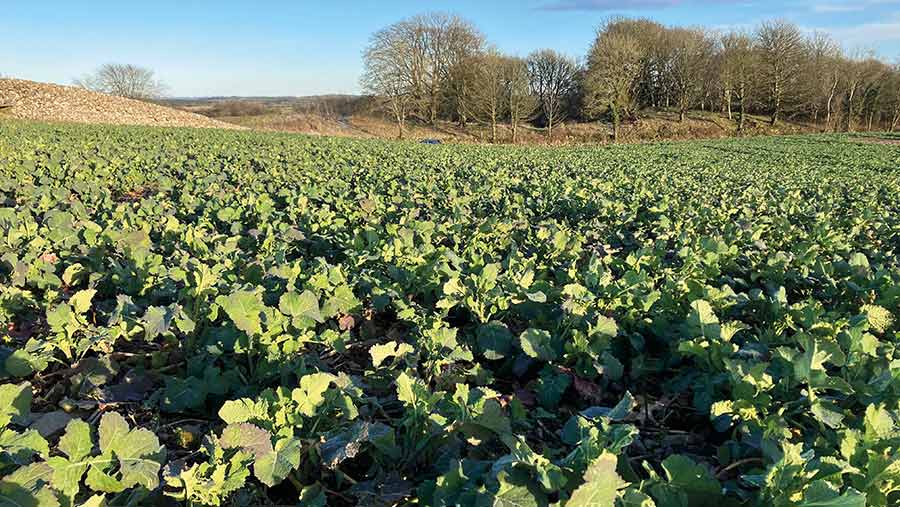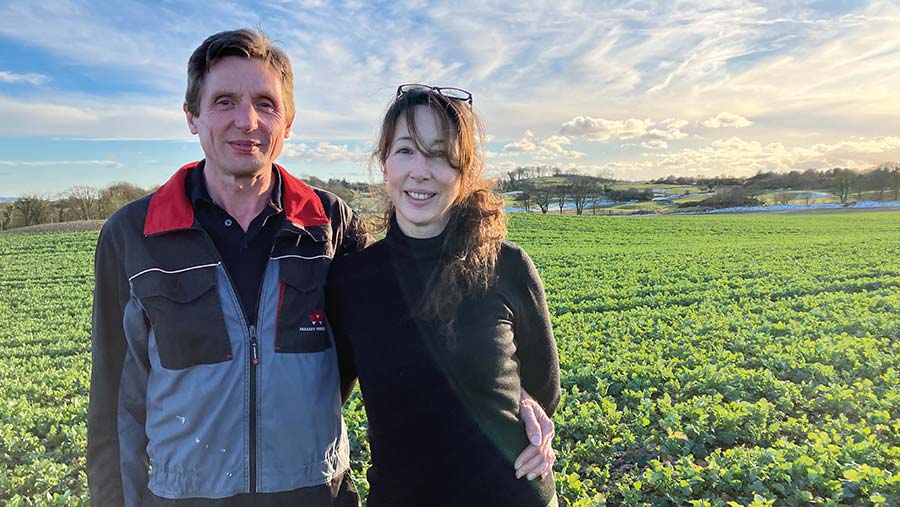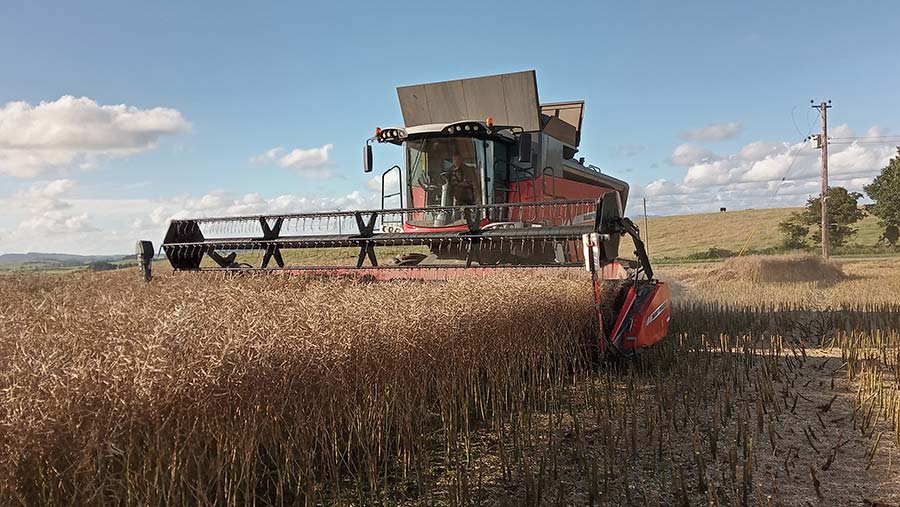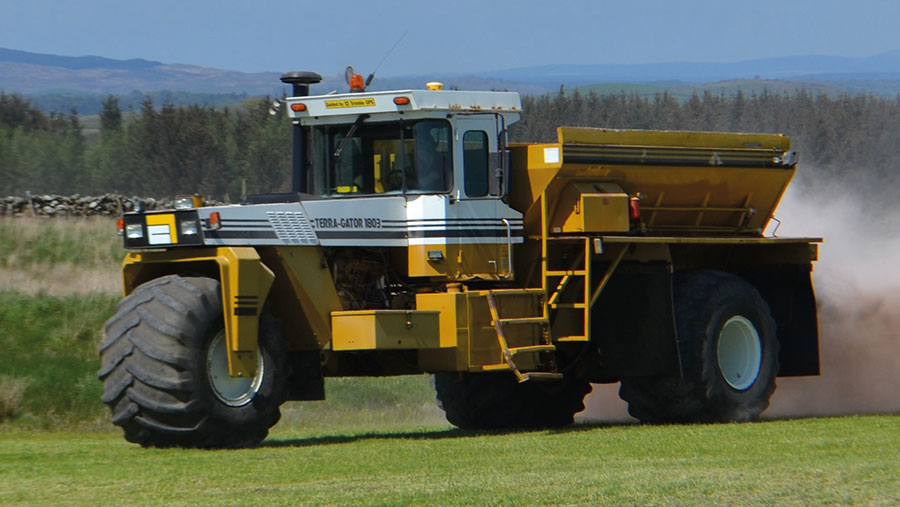Ex-beef farmer reveals how he grew award-winning OSR crop
 © MAG/Emma Gillbard
© MAG/Emma Gillbard Tucked into the south-west corner of Scotland in an area dominated by livestock, lies the Lawson’s arable farm which yielded a surprise 6.2t/ha crop of oilseed rape.
What started out as a suckler farm with up to 600 head of cattle, Airlies Farm has since evolved into a full-scale arable unit run by brothers Mark, Philip and Ben, alongside Mark’s wife Gina.
A rotation of winter wheat, winter barley and winter oilseed rape is in place.
See also: New advice on volunteers for tackling flea beetle in OSR
With a strong focus and drive to improve crop performance, Mark Lawson’s crop of Acacia oilseed rape won silver in the 2022 Yield Enhancement Network (YEN) awards, achieving an impressive 84% of its 7.4t/ha yield potential.
“A silver win was really unexpected. Our farm average oilseed rape yields are about 3.7t/ha and if we push this to more than 4t/ha we are happy, let alone over 6t/ha.
“Our objective is to produce this level of yield consistently, year-on-year,” he says.

Mark and Gina Lawson © Emma Gillbard
Transitioning beef to arable
Airlies Farm is located in Wigtownshire, a 40-minute drive from the coast of Stranraer, and stands out among its neighbours with its purely arable rotation.
“Converting from beef to arable certainly didn’t come without its challenges, especially when the farm is situated in a Scottish less favoured area,” says Mr Lawson, who reflects on the “months and months” spent de-stoning the land.
He highlights how “the excavator was the most used machine on farm” and that growing crops on just 10-12cm of topsoil can be challenging.
Since 1989, the Lawsons had run a 230 cow suckler herd, but faced with increased feed and transport costs, the brothers decided to grow their own. Grain was kept as livestock feed while straw was used for bedding.
“We started trialling whole crop barley, wheat and triticale. After a few successful years, we ended up buying a 10-year-old Massey Ferguson 40RS auto-level machine with a 20ft header.
“We were impressed how the auto-level worked on our steep land,” says Mr Lawson.
It wasn’t long before a local grain merchant asked if the farm had surplus grain for sale, and from that the enterprise began to grow and grow. In 2017, the final cattle were sold.
However, being the only arable farm in a predominantly livestock area comes with many benefits.
“Pests and disease pressures are low and the different cropped environments benefit different wildlife species,” explain Mr and Mrs Lawson.
Of the 320ha farm, 240ha is now under arable production with a rotation of winter wheat, winter barley and winter oilseed rape. Grass is grown for silage to support the farm’s bed and breakfast cattle lets.

© Mark Lawson
Winning ways
Mr Lawson reveals that it was a conversation with seed advisor Douglas Bonn of Nickersons which convinced him to enter YEN and explains the competition was a really positive experience.
“When the awards were announced we couldn’t believe it.”
The winning oilseed crop was planted in August with a 6m Sulky disc drill at a seed rate of 3.55kg/ha, with an aim of 24 plants/sq m. Land was lightly cultivated with a Simba Xpress.
He aims to drill rapeseed as early as possible in August as he describes the weather as “a cliff edge”. Although drilling into September is plausible, success or failure seems to be a lottery.
“The season before last, we lost all our rapeseed crops when we drilled in September after a late winter barley harvest.
“The OSR just about made it through to January, but with three to four weeks of freezing wind, crops burned off, and attacked by slugs and rabbits.”
The focus is on winter cropping as the farm’s shallow and stoney soils which present just 10-12cm of top soil do not suit spring drilling in dry conditions.
But with such shallow soils restricting the development of deep burrowing tap roots – often deemed essential for effective nutrient and water uptake – how did crops perform so well?
In an area of high winter rainfall, shallow soils enable some reprieve as water percolates through the top soil.
This provides crops with a plentiful and accessible supply of water to combat the shallow root structures.
Agronomy
The crop came out of the winter well, so a growth regulation was applied at stem extension alongside a broad spectrum foliar feed and a total of 220kg N/ha.
Tissue analysis highlighted the crop was short of boron. A four-way mix of boron, carboxamide and triazolinthione fungicide for sclerotinia and a biostimulant spray was applied early-flowering.
Being so far north, the flowering period can last for many weeks, which prompted a second mid-flowering application.
This time, a crop enhancer to increase chlorophyll and maximise green leaf area was added.
Light leaf spot is the main disease threat at Airlies, but a robust spray programme keeps it in check.
“Harvest commenced on 5 August after a spraying off with glyphosate 10 days prior. We struggled to get the YEN crop into the trailer – so we knew we were onto some high yields.”
“We treated all rapeseed crops exactly the same as we wanted to use the YEN report to see how we could improve across the whole farm. There is always more to learn,” concludes Mr Lawson.
The importance of lime

© Mark Lawson
Correcting pH levels was a key hurdle to overcome when converting the farm, with liming required annually.
Following difficulty finding reliable contractors, the family decided to take the job on themselves, purchasing a 20-year old Terra-Gator 1803 self-propelled lime spreader (pictured above), which has proven its worth.
“Our pHs are now 6.9-7.0 thanks to regular liming. It is an easy thing to neglect, but it has made a huge difference to soils,” says Mr Lawson.
Wet autumn leaves half of winter area drilled
The Lawson family base their rotation on winter crops of wheat, barley and oilseed rape as spring crops grown in such shallow soils find it difficult to establish in dry conditions.
However, this season an extremely wet autumn prevented half of the winter area from being sown, leaving 120ha destined for spring barley.
Two varieties will be sown: Westminster and new addition Mermaid which is commonly grown in Northern Ireland.
Mark Lawson has recently purchased a second-hand direct drill and plans to trial this across the spring barley area. Also on order is a new Massey 8S.305 which he hopes will arrive before drilling commences.
What makes oilseed rape yield well?
A decade of YEN research shows that while light and water availability remain critical limiting factors to yield, successful crops must optimise biological growth to convert available energy into grain.
Maximising biomass puts crops in a prime position to convert sunlight into yield.
Historic YEN weather analysis and OSR yields reveal high yielding seasons are associated with a warm October, dry December, warm March, dry and sunny April, and a wet cool May.

